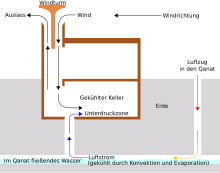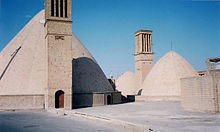Badgir


A badgir ( Persian بادگیر, DMG bādgīr , 'wind catcher') is a traditional Persian architectural element as a wind tower , which has been used for centuries for natural ventilation of buildings. Badgires are still used today in a wide variety of variants. A badgir usually has at least two vertical channels.
Wind towers are also found in the Arab world, as well as in Pakistan, Afghanistan, and other areas of West Asia that have been influenced by Persian architecture. A wind tower is mentioned in an Egyptian source from 1300 BC. The Egyptian name is Malqaf (plural Malaaqef ).
The Badgir is a massive tower that extends from the lowest rooms of a building to over the roof. It is divided, mostly into four vertical ventilation ducts, which are open at the top in all four directions and can be closed individually for control. The Badgir can have different effects depending on its design and integration into the building, the location and, above all, the current climatic situation and can be combined with other facilities.
The height of the tower allows a chimney effect based on heat flow , the supply of fresher air and the unhindered action of the wind. In densely built-up settlements, additional freedom opens up because the building can be oriented towards the sun, regardless of a main wind direction, in order to avoid strong irradiation in the windows. Now that electromechanical fans and air conditioning systems have increasingly been used, badgires are coming back into focus with regard to economy and sustainability.
Basic functions
If the temperature inside the building is higher than outside and there is no wind, the chimney effect takes effect. This can happen especially at night. The cold night air flows through the building and Badgir and cools the walls, which act as heat buffers. The heated air rises in the Badgir and escapes. If, on the other hand, a wind blows, the current is reversed. The dynamic pressure on the side facing the wind direction ( windward ) pushes the cold air through the Badgir, which is cooled in the process, but this does not lead to a significant warming of the air. The warm air mostly flows from different openings depending on the pressure conditions. Once the addition flowing air is cooler than the walls, it cools all flow around surfaces, including the channel in Badgir that on the leeward side ( Lee opens). In addition, the walls of the tower and building, especially the roof, radiate heat at night.
If the ambient temperature falls below the indoor temperature when there is no wind, the air in the Badgir falls downwards and a reverse chimney effect occurs. The air cools down on the inner walls of the tower, which are cooled down at night, and ventilates the interior. By largely closing the openings, the flow can be slowed down in order to make better use of the “stored coolness”, i.e. not to heat up the tower walls prematurely and to utilize the heat capacity corresponding to the temperature difference by storing heat. Often it is still quite cool in the building and only carbon dioxide and other substances should be discharged through the door or other deep openings. If the temperature of the walls rises above the air temperature, the air flow is reversed and the tower acts as a chimney with an ascending flow. If, on the other hand, there is wind in this situation, the air flows down the tower, counter to the chimney effect, due to the dynamic pressure effect and pressure difference between windward and leeward, through the opposite channel back up and out of the opening on the leeward. Air exchange takes place through the openings to the rooms and movement is brought into the room air. Depending on the design and situation, air can flow out or in through the window in a room. If the static pressure in the flowing air is below the natural air pressure as a result of the Bernoulli effect , the room air under natural air pressure can flow into the Badgir. It is discharged via the canal ( lee ). These processes allow the room temperature to approach the night outside air temperatures.
Use of evaporative cooling
In addition to the exchange of air, the air flow in Badgir also causes the air to circulate within the building. This also cools the skin of the residents and the air that brushes over plants through the help of perspiration . If an air flow is guided over a water surface or damp surfaces through the design of the Badgir and rooms, additional cooling occurs through evaporation with the evaporation cold . This can happen directly when the humidified, cooled air gets into the rooms or stays there, or indirectly when this air cools the walls of the badgir. In later situations, these can absorb heat from the air flowing in the other direction and thus cool them. Often water basins or fountains are arranged in the air flow.
The length of the ducts, and thus the heat capacity and the amount of water available for evaporation and cooling, can be increased, among other things, by a ventilation duct located in the ground. The badgir is then at a distance from the building. The cooling effect can be enhanced by planting and watering the soil above the Badgir, as the water then evaporates in the canal. This only works if an inflow from the Badgir to the building is achieved.
The Badgir can also work with other systems. If the air flow is guided over the opening of a shaft, which is a connection to a qanat running under the building, the air, which is swept over the water in the qanat and thus cooled, rises from the shaft into the rooms. This happens because the flowing air exerts a lower static pressure than the natural air pressure at the location of other shafts of the qanat when there is no or less current, i.e. little wind, directly on the ground. The other situations mentioned above can also lead to a draft from the qanat into the building.
The wind catchers are also used for cooling rooms ( Yachtschāl ) and water reservoirs ( Âb Anbārs ) and are able to use the evaporative cold to cool the stored water to a temperature close to freezing for months in summer. There is an opening at the highest point of the domed roof of this room. There the wind speed is greatest in accordance with the Venturi effect, and there is less pressure in accordance with the Bernoulli effect. One or often four badgires supply air to the cistern. The air sweeps over the water, the upper warm water layer evaporates, the evaporation cold cools the water, and the moist, warm air escapes through the low-pressure upper opening.
Chane-ye_Borudscherdi in Kashan in the center of Iran was built in 1857 and is an example of the old Persian building culture in desert areas. The two high wind towers cool the private rooms ( Andaruni ) of the building.
The wind tower of a house made of palm fronds in Dubai .
Golestan Palace in Tehran , Iran
Souq Waqif , Doha , Qatar
The badgir of Dowlat-abad in Yazd is one of the tallest wind catchers
See also
Web links
- http://www.fhnw.ch/habg/iebau/dokumente-1/nds-e/passive-kuehler-mit-luft.pdf Passive cooling with air Principles from bionics and their application in traditional and contemporary architecture , Annette Aumann and Olaf Kortus, Muttenz, June 2007 (postgraduate studies in energy, diploma thesis; PDF file)
- Yazd, the city of badgires
- The famous "Dowlat-abad" wind catcher in Yazd
- http://www.staedtebauliche-klimafibel.de/pdf/Klimag-B-EU-2000.pdf (PDF file; 4.71 MB)
- http://www.hslu.ch/download/t/t-ama_2007_textbuch_070912.pdf (PDF file; 1.22 MB)
- "Bādgire - How do you catch winds?" , Regensburg-digital from August 13, 2008 about Bādgire and ice storms in Iran.
Individual evidence
See also
- Cowl (curved supply duct for ships)








